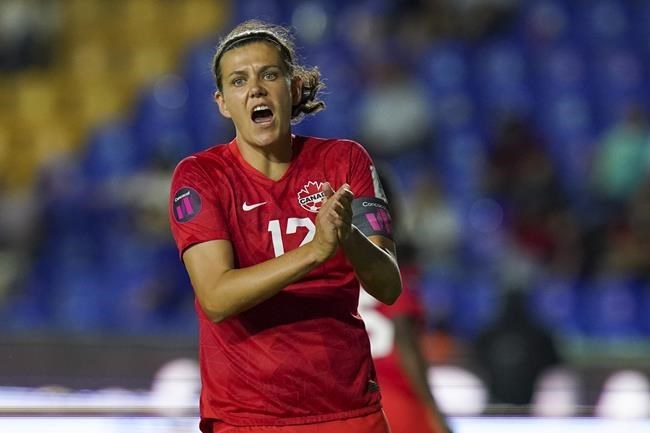Within minutes of learning her team's path at the 2023 FIFA Women's World Cup, Canada coach Bev Priestman was looking deep into the draw.
The seventh-ranked Canadians avoided some of the tournament heavyweights in being drawn with co-host Australia, Ireland and Nigeria in Group B.
Australia, at No. 13, was the second-lowest-ranked team the Olympic champion Canadians could have faced out of Pot 1. Only co-host New Zealand, at No. 22, had a lower ranking in the pot containing the co-hosts and top seeds.
And Priestman's team is familiar with Australia and No. 45 Nigeria, having played both twice this year. Ireland, ranked 24th, will be making its World Cup debut.
"I'm excited," Priestman, speaking from Auckland, said of Saturday's draw. "It could be worse, it could be better.
The top two in each pool will advance to the round of 16 with the Group B winner facing the runner-up in Group D and the Group B runner-up taking on the Group D winner.
That means a possible challenging date with No. 4 England, No. 15 China or No. 18 Denmark.
The expanded 32-country field made for a more benign landing zone for most top teams. But Group D is one of the tougher neighbourhoods and Olympic champion Canada will have to get through it to reach the quarterfinals.
Priestman said the goal will be to win the group, so as to avoid a likely meeting with in-form England, which defeated the top-ranked Americans last month.
Canada defeated Australia twice in September, 1-0 and 2-1 in Brisbane and Sydney respectively, and is 6-2-2 against the Matildas this century. Having just played Down Under, it also knows what to expect.
The Canadians won their only meeting with Ireland, 2-1 in 2014.
But the draw did not do Canada any favours in No. 45 Nigeria, the highest-ranked team in Pot 4. The Super Falcons have never missed a World Cup and made the quarterfinals in 1999.
Canada is 2-1-2 all-time against Nigeria, recording a 2-0 win and 2-2 tie when they met in a pair of matches in April in B.C.
"Nigeria are a very difficult team to play," said Priestman.
Two of their earlier matchups came in past World Cups. The two teams tied 3-3 at the 1995 tournament and Canada lost 1-0 to Nigeria in a disastrous showing at the 2011 competition where it finished last.
The opening matches next year will see New Zealand play Norway in Auckland and Australia face Ireland in Sydney, both on July 20 (local time).
The Canadians will play their opening-round games in Australia, starting with Nigeria on July 21 in Melbourne. Canada will then face Ireland on July 26 in Perth before meeting Australia on July 31 back in Melbourne.
The draw means Canada will play all of its matches in Australia, including the knockout rounds.
No. 3 Germany or No. 5 France could await Canada in the quarterfinals
It's the first Women's World Cup to be held in two countries, the first with an expanded 32-country field, up from 24, and the first in the Southern Hemisphere.
"It's getting real!!!" tweeted Canadian defender Vanessa Gilles.
The 64-game tournament is scheduled to run through Aug. 20 across 10 different venues in nine different cities — five cities in Australia and four in New Zealand.
Priestman and Canada Soccer general secretary Earl Cochrane were in the audience for the draw, along with FIFA president Gianni Infantino, New Zealand Prime Minister Jacinda Ardern and Anika Wells, Australian federal minister for sport Anika Wells. Canadian Victor Montagliani, president of CONCACAF and a FIFA vice-president, was also on hand.
The trophy was also there, brought in by former U.S. coach Jill Ellis, who won it in 2015 and 2019.
Former players Carli Lloyd, Alexi Lalas, Gilberto Silva and Ian Wright were among those taking part in Saturday's ceremony at Auckland's Aotea Centre.
The 29 qualified teams along with three slots yet to be filled were divided into four pots by seeding for the draw.
Canada was placed in Pot 2, which also included the eighth-ranked Netherlands, No. 9 Brazil, No. 11 Japan, No. 12 Norway, No. 14 Italy, No. 15 China and No. 17 South Korea.
In addition the tournament co-hosts, Pot 1 featured the top-ranked U.S., No. 2 Sweden, No. 3 Germany, No. 4 England, No. 5 France and No. 6 Spain.
Canada was kept away from the U.S. and fellow CONCACAF sides Costa Rica and Jamaica under FIFA's "general principle" that no group has more than one team from the same confederation.
That does not apply to Europe, because of the number of possible entrants — 11 or possibly 12 depending in the playoff tournament.
The Philippines, Morocco, Vietnam and Zambia will also be making their Women's World Cup debut.
Vietnam, ranked 34th, lands in the deep end with an opening game against the four-time champion U.S.
At the 2019 World Cup in France, Canada was drawn in a pool with the Netherlands, Cameroon and New Zealand. The Canadians finished second to the Dutch in the group and lost 1-0 to Sweden in the round of 16.
The Canadian women are 10-2-3 this year and have won four straight since losing 1-0 to the U.S. in the final of the CONCACAF W Championship in Mexico in July.
Canada's best finish at the World Cup was fourth in 2003.
The three remaining teams for the 2023 competition will come from the 10-team Inter-Confederation Playoff Tournament, scheduled for Feb. 17-23 in Auckland.
The field features two teams from Asia (Chinese Taipei and Thailand), two from Africa (Cameroon and Senegal), two from CONCACAF (Haiti and Panama), two from South America (Chile and Paraguay), one from Oceania (Papua New Guinea) and one from Europe (Portugal).
---
Follow @NeilMDavidson on Twitter
This report by The Canadian Press was first published Oct. 22, 2022
Neil Davidson, The Canadian Press



